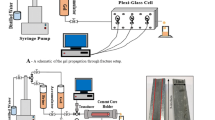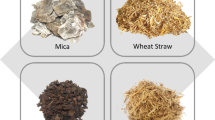Abstract
Addressing the complex issue of lost circulation in drilling operations is crucial as it increases nonproductive time and costs. Conventional gel plugging materials often exhibit low temperature resistance, poor pumpability, and low pressure-bearing capacity. To overcome the limitations, a self-made polymer (HSA) was initially synthesized and mixed with two crosslinker agents (MBA/PEI) at room temperature to induce a new type of high-temperature-resistant and pressure-resistant polymer gel agent (HSA-G). Investigating the gel strength and plugging capacity, the vertical inverted tube observation, 71-type high-temperature and high-pressure (HTHP) instruments, and high-pressure filter with varying fracture cracks (3–5 mm) were employed. HSA-G demonstrated excellent gelation strength for 4–5 h at 140 °C, while retaining more than 57% of its gel strength after aging at 140 °C for 144 h, which is 3 times higher than the commercially available hydrolyzed polyacrylamide (HPAM + PEI). The excellent performance was attributed to the synergy between PEI-MBA, which induces tight-crosslinked interconnected structure within HSA-G, mitigating fluid losses to only 72 mL compared to 194 mL for HPAM-G, under 8.5 MPa in the HTHP sand bed at 140 °C. In the fracture leakage simulations using a 5 mm crack performed at 6 MPa at room temperature, the filtration loss of HSA-G is 300 mL, almost half that of HPAM-G, showcasing its superior plugging and high-pressure bearing performance. In conclusion, HSA-G has not only demonstrated operational effectiveness in reducing downtime costs and fluid losses but can also temporally replace cement plugging to prevent reservoir contamination in alignment with environmentally friendly practices.










Similar content being viewed by others
Data Availability
Data will be made available on request to the corresponding author.
References
Feng Y, Gray KE (2017) Review of fundamental studies on lost circulation and wellbore strengthening. J Pet Sci Eng 152:511–522. https://doi.org/10.1016/j.petrol.2017.01.052
Magzoub MI, Salehi S, Hussein IA, Nasser MS (2020) Loss circulation in drilling and well construction: the significance of applications of crosslinked polymers in wellbore strengthening: a review. J Pet Sci Eng 185:106653. https://doi.org/10.1016/j.petrol2019.106653
Xu C, Yang X, Liu C, Kang Y, Bai Y, You Z (2022) Dynamic fracture width prediction for lost circulation control and formation damage prevention in ultra-deep fractured tight reservoir. Fuel 307:121770. https://doi.org/10.1016/j.fuel.2021.121770
Yang J, Sun J, Bai Y, Lv K, Zhang G, Li Y (2022) Status and prospect of drilling fluid loss and lost circulation control technology in fractured formation. Gels. 8:260. https://doi.org/10.3390/gels8050260
Sun J, Bai Y, Cheng R, Lyu K, Liu F, Feng J, Lei S, Zhang J, Hao H (2021) Research progress and prospect of plugging technologies for fractured formation with severe lost circulation. Pet Explor Dev 48(3):732–743. https://doi.org/10.1016/S1876-3804(21)60059-9
Alshubbar G, Nygaard R, Jeennakorn M (2018) The effect of wellbore circulation on building an LCM bridge at the fracture aperture. J Pet Sci Eng 165:550–556. https://doi.org/10.1016/j.petrol.2018.02.034
Nasiri A, Ghaffarkhah A, Keshavarz Moraveji M, Gharbanian A, Valizadeh M (2017) Experimental and field test analysis of different loss control materials for combating lost circulation in bentonite mud. J Nat Gas Sci Eng 44:1–8. https://doi.org/10.1016/j.jngse.2017.04.004
Liu P, Falin W, Zhang S, Zhu X, Wang L, **ong C (2018) A bull-heading water control technique of thermo-sensitive temporary plugging agent. Pet Explor Dev. https://doi.org/10.1016/S1876-3804(18)30059-4
Du Q, Hou J, Fan Z, Zhou K, Liu W, Liu Y (2019) A new organic fiber composite gel as a plugging agent for assisting CO2 Huff and puff in water channeling reservoirs. J Petrol Sci Eng 179:70–79. https://doi.org/10.1016/J.PETROL.2019.04.034
Jiang Q, Xu P, Xu J, Hou M, Liu Q, Dai B (2023) Preparation and evaluation of composite hydrogel for reducing the leakage rate of lost circulation. Polymers 15:4218. https://doi.org/10.3390/polym15214218
Fan X, Zhao P, Zhang Q, Zhang T, Zhu K, Zhou C (2018) A polymer plugging gel for the fractured strata and its application. Materials 11(5):856. https://doi.org/10.3390/ma11050856
Hamza A, Shamlooh M, Hussein IA, Nasser M, Salehi S (2019) Polymeric formulations used for loss circulation materials and wellbore strengthening applications in oil and gas wells: a review. J Petrol Sci Eng 180:197–214. https://doi.org/10.1016/j.petrol.2019.05.022
Horton RL, Prasek B, Growcock FB, Vian JW, Ivan CD (2016) Prevention and treatment of lost circulation with crosslinked polymer material. U.S. Patent 7,098,172
Yao E, Yu G, Li B, Zhao L, Li Y, Bai H, Zhou F (2022) High-temperature-resistant, low-concentration water-controlling composite cross-linked polyacrylamide weak gel system prepared from oilfield sewage. ACS Omega 7:12570–12579. https://doi.org/10.1021/acsomega.1c05675
Ishiwata T, Furukawa Y, Sugikawa K, Kokado K, Sada K (2013) Transformation of metal–organic framework to polymer gel by cross-linking the organic ligands preorganized in metal–organic framework. JACS 135(14), 5427–5432. https://doi.org/10.1021/ja3125614
Jiao F (2019) Practice and knowledge of volumetric development of deep fractured-vuggy carbonate reservoirs in Tarim Basin, NW China. Pet Explor Dev 46(3):576–582. https://doi.org/10.1016/S1876-3804(19)60037-6
**e B, Ma J, Wang Y, Tchameni AP, Luo M, Wen J (2021) Enhanced hydrophobically modified polyacrylamide gel for lost circulation treatment in high temperature drilling. J Mol Liquids 325:115155. https://doi.org/10.1016/j.molliq.2020.115155
Li H, Liu H, He Z, Li Z, Zhang S, Li Q (2019) Use gel to control severe mud losses in carbonate reservoir formations in Tahe oilfield. Drill Fluid Complet Fluid 36(1):25–28. https://doi.org/10.3969/j.issn.1001-5620.2019.01.005
Yan B, Jiang G, Hu W, **ang X, Deng Z (2019) Study on high temperature delayed crosslinking PAM Gel LCM. Drill Fluid Complet Fluid 36(6):679–682. https://doi.org/10.3969/j.issn.1001-5620.2019.06.003
Offiler C, Jones C, Steed J (2017) Metal turn-off, anion turn-on gelation cascade in pyridinylmethyl ureas. Chem Commun 53:2024–2027. https://doi.org/10.1039/C6CC09126A
Yang C, Wu S, ** S, Liu C, **g Y (2021) Research and evaluation of high temperature and high pressure resistant composite plugging gel. Liaoning Chem Ind 50(12):1785–1788. https://doi.org/10.14029/j.cnki.issn1004-0935.2021.12.011
Uspenskaya M, Deĭneka G, Sirotinkin N (2006) A multivariate analysis of the IR spectra of tetrazole-containing copolymers. Opt Spectrosc 100:204–208. https://doi.org/10.1134/s0030400x06020093
Li X, **e B, Zhao L (2018) Synthesis and evaluation of new heat-resistant and salt-tolerant polymer viscosifier. Petrochem Technol 47(6):595–599. https://doi.org/10.3969/j.issn.1000-8144.2018.06.012
Guo Y, Yan B, Huang Y, Li L, Jiang G, Deng Z (2019) Development and evaluation of a high temperature gelling and degradable polymer lost circulation material. Drill Fluid Complet Fluid 36(3):293–297. https://doi.org/10.3969/j.issn.1001-5620.2019.03.005
Reid R, Sgobba M, Raveh B, Rastelli G, Sali A, Santi D (2015) Analytical and simulation-based models for drug release and gel-degradation in a tetra-PEG hydrogel drug-delivery system. Macromolecules 48(19):7359–7369. https://doi.org/10.1021/acs.macromol.5b01598
Sydansk RD, Argabright PA (1987) Conformance improvement in a subterranean hydrocarbon-bearing formation using a polymer gel. US4683949, USA
Deng Z, Jiang G, Yang L, He Y, Ni J (2018) Microencapsulation of 2,2′-azobis(2-methylpropionamide) dihydrochloride initiator using acrylonitrile butadiene styrene as shell for application in lost-circulation control. Colloids Surf A Physicochem Eng Asp 553:134–142. https://doi.org/10.1016/j.colsurfa.2018.05.016
Li C, Yang S, Wen Z, Pan Y, Zeng F, Zhao C (2020) Abouleilah H The research of new type gel plugging agent for deep well. Energy Sources A Recovery Util Environ 1:1–15. https://doi.org/10.1080/15567036.2020.1756538
**e B, Ma J, Wang Y, Tchameni A, Luo M, Wen J (2021) Enhanced hydrophobically modified polyacrylamide gel for lost circulation treatment in high temperature drilling. J Mol Liq 325:115155. https://doi.org/10.1016/j.molliq.2020.115155
Magzoub MI, Shamlooh M, Salehi S, Hussein I, Nasser MS (2021) Gelation kinetics of PAM/PEI based drilling mud for lost circulation applications. J Petrol Sci Eng 200:108383. https://doi.org/10.1016/j.petrol.2021.108383
Zhao S, Ge J, Zhu J, Zhang H (2021) Research on high-strength PEI gel used for oil well water plugging. Oilfield Chem 38(3):434–439. https://doi.org/10.19346/j.cnki.1000-4092.2021.03.010
Mohamed AI, Hussein IA, Sultan AS, El-Karsani KS, Al-Muntasheri G (2015) A. DSC investigation of the gelation kinetics of emulsified PAM/PEI system: influence of surfactants and retarders. J Therm Anal Calorim 122:1117–1123. https://doi.org/10.1016/j.petrol.2021.108383
Dou L, Zhu Y, Ji Y (2021) Synthesis and solution properties of AM/PTDAB/AMPS/NaAA quaternary copolymer. Oilfield Chem 38(01):119–124. https://doi.org/10.19346/j.cnki.1000-4092.2021.01.022
Djouonkep LDW, **e B, Tao H, Chen J, Zhuo L, Selabi NBS, Zhao L (2024) Enhanced amphoteric polymer filtration reducer with vinyl-functionalized nanosilica for high-salt and ultra-high temperature water-based drilling environments. Geoenergy Sci Eng 236:212743. https://doi.org/10.1016/j.geoen.2024.212743
Zhu D, Wang Z, Liu Y, Zhang H, Qin J, Zhao Q, Wang G, Shi C, Su Z (2022) Carbon nanofiber-enhanced HPAM/PEI gels for conformance control in petroleum reservoirs with high temperatures. Energy Fuels 36(20):12606–12616. https://doi.org/10.1021/acs.energyfuels.2c02866
Djouonkep LDW, **e B, Tao H, Chen J, Zhuo L, Songwe Selabi NB, Tchameni AP, Zhao L (2024) Thermo-thickening/amphoteric polymer nanocomposite incorporating vinyl-functionalized nano-silica as a viscosifier for high-salt and ultra-high temperature water-based drilling fluids. J Mol Liq 404:124866. https://doi.org/10.1016/j.molliq.2024.124866
Huang B, Zhang W, Zhou Q, Fu C, He S (2020) Preparation and experimental study of a low-initial-viscosity gel plugging agent. ACS Omega 5(25):15715–15727. https://doi.org/10.1021/acsomega.0c02242
Muhammed NS, Haq B, Al Shehri D, Al-Ahmed A, Rahman MM, Zaman E (2022) A review on underground hydrogen storage: insight into geological sites, influencing factors and future outlook. Energy Rep 8:461–499. https://doi.org/10.1016/j.egyr.2021.12.002
Zhang T, Ge J, Wu H, Guo H, Jiao B, Qian Z (2022) Effect of AMPS (2-acrylamido-2-methylpropane sulfonic acid) content on the properties of polymer gels. Pet Sci 19(2):697–706. https://doi.org/10.1016/j.petsci.2022.01.006
Wang Q, Cai J, Wang J, Zhou C, Wen X, Zhang J, Mao H (2024) Development and application of the anti-high-temperature delayed crosslinking polymer as a gel plugging additive for drilling fluid. Gels 10(1):73. https://doi.org/10.3390/gels10010073
Xu D, Zheng Y, Zhang S, Zhao Y, Li W, Shen D (2015) Application progress of weak gel systems in oilfield profile control technology. Chem Eng Prog 34(05):1323. https://doi.org/10.16085/j.issn.1000-6613.2015.05.024
Stanković B (2021) Effect of the swelling degree on the non-isothermal dehydration kinetics of a poly (acrylic acid)-g-gelatine hydrogel. J Soft Matter 17(45):10383–10393. https://doi.org/10.1039/D1SM01139A
**n F, Lyu Q (2022) A review on thermal properties of hydrogels for electronic devices applications. Gels 9(1):7. https://doi.org/10.3390/gels9010007
Etzold M, Linden P, Worster M (2021) Transpiration through hydrogels. J Fluid Mech 925:A8. https://doi.org/10.1017/jfm.2021.608
Jia H, Chen H, Guo S (2017) Fluid loss control mechanism of using polymer gel pill based on multi-crosslinking during overbalanced well workover and completion. Fuel 210:207–216. https://doi.org/10.1016/J.FUEL.2017.08.032
Hiei Y, Ohshima I, Hara M, Seki T, Hoshino T, Takeoka Y (2022) Shrinking rates of polymer gels composed of star-shaped polymers of N-isopropylacrylamide and dimethylacrylamide copolymers: the effect of dimethylacrylamide on the crosslinking network. Soft Matter 18(28):5204–5217. https://doi.org/10.1039/d2sm00402j
Song T, Bai B, Eriyagama Y, Schuman T (2023) Lysine crosslinked polyacrylamide a novel green polymer gel for preferential flow control. ACS Appl Mater Interfaces 15(3):4419–4429. https://doi.org/10.1021/acsami.2c17390
Soares A, Freitas J, Melo D, Braga R, Amaral-Machado L, Santos P, Soares L (2017) Cement slurry contamination with oil-based drilling fluids. J Pet Sci Eng 158:433–440. https://doi.org/10.1016/J.PETROL.2017.08.064
Tang G, Yan H, Li J, Song X, Zhang X, Guo X (2020) Sealing analysis of cement plug in offshore abandoned wells. Mater Sci Forum 993:1333–1340. https://doi.org/10.4028/www.scientific.net/MSF.993.1333
Acknowledgements
We would like to thank the financial support from the Open Foundation of Cooperative Innovation Center of Unconventional Oil and Gas, Yangtze University (Ministry of Education & Hubei Province), No. UOG2024-11.
Funding
Preparation and Mechanism of Thermo-sensitive Associative Plugging Agent for Shale Formation (No. UOG2024-11).
Author information
Authors and Affiliations
Contributions
Chen **dong: Conceptualization, Data curation, Formal analysis, Funding acquisition, Methodology, Writing—original draft. Qiu Hengbin: Investigation, Visualization, Writing—review and editing. Lesly Dasilva Wandji Djouonkep: Resources, Supervision, revision. Lv Junxian: Project administration Validation. **e Binqiang: Investigation, Visualization, Writing—review and editing.
Corresponding authors
Ethics declarations
Conflict of interest
The authors declare that they have no conflict of interests.
Additional information
Publisher’s Note
Springer Nature remains neutral with regard to jurisdictional claims in published maps and institutional affiliations.
Rights and permissions
Springer Nature or its licensor (e.g. a society or other partner) holds exclusive rights to this article under a publishing agreement with the author(s) or other rightsholder(s); author self-archiving of the accepted manuscript version of this article is solely governed by the terms of such publishing agreement and applicable law.
About this article
Cite this article
Chen, J., Qiu, H., Djouonkep, L.D.W. et al. Preparation, Evaluation and Field Application of Thermally Induced Crosslinked Polymer Gel Leakage Plugging Agent. J Polym Environ (2024). https://doi.org/10.1007/s10924-024-03334-1
Accepted:
Published:
DOI: https://doi.org/10.1007/s10924-024-03334-1




